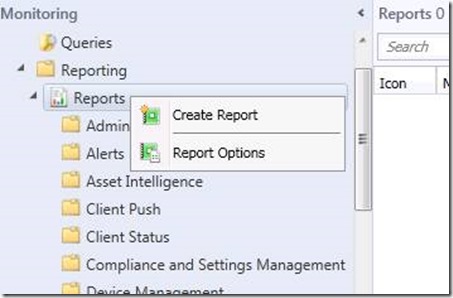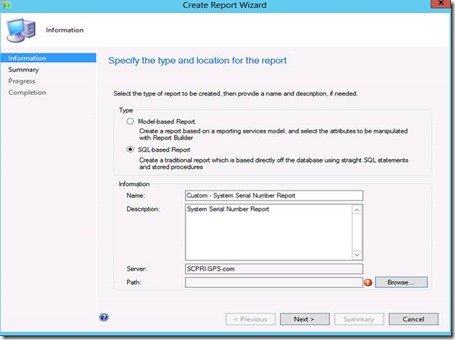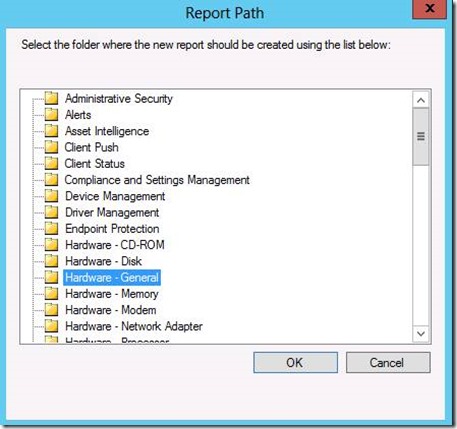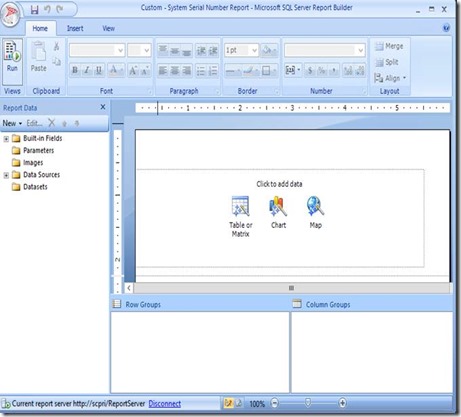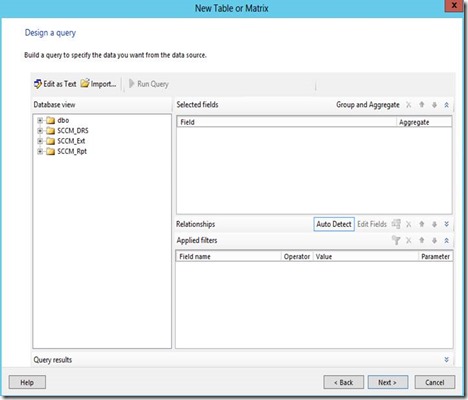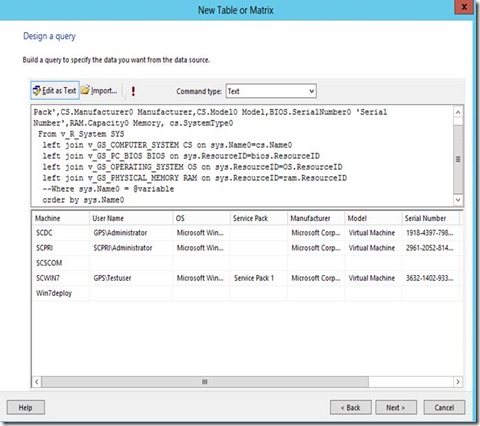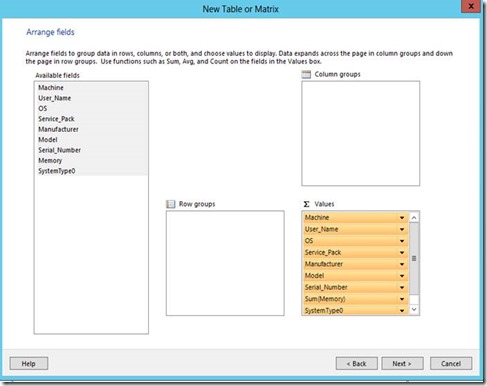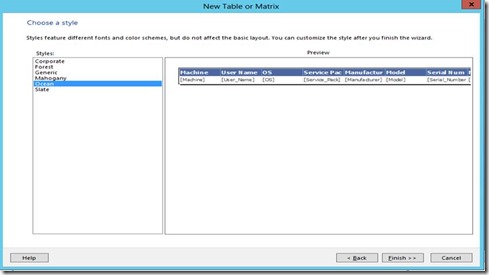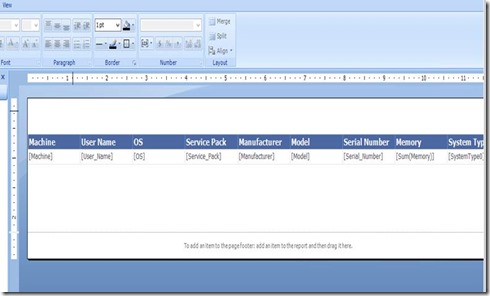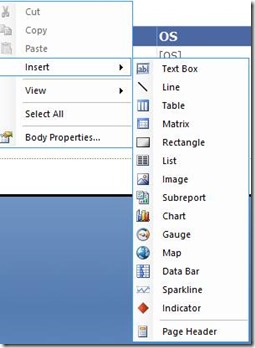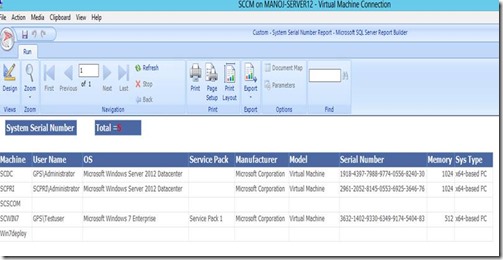SCCM 2012 Reporting: Get system serial number & create custom SSRS report
Once again our expert Manoj Kumar sharing his valuable insight on SCCM 2012 Reporting.
In Configuration manager 2012 we do not have an out of the box report which shows the system serial number. Below is a very simple report which includes: System Name, User Name, OS, Service Pack, Manufacturer, Serial Number, Model & System Type.
This step by step guide will show you how to setup your custom report to show-up the system serial number.
Open SCCM console and open the Monitoring > Overview > Reporting> Right click the “Reports” node and click on Create Report.
Click on SQL- Based Report
Click to Browse the category to save the report in
Click OK and then Click Next till you reach summary page and then close after the report is created.
When you finish the report the SQL Server Report Builder should now open.
If you already see data source connection, just hit Test Connection toverify it If not, then click Browse Enter in the credentials that have access to the SCCM database and click Next.
You’ll now hit the “Design a query” Click on Edit as Text in the top left corner.
Paste the below query and hit red color Exclamation Mark just next to import
Select sys.Name0 Machine, CS.UserName0 'User Name',OS.Caption0 OS, OS.CSDVersion0 'Service Pack',CS.Manufacturer0 Manufacturer,CS.Model0 Model,BIOS.SerialNumber0 'Serial Number',RAM.Capacity0 Memory, cs.SystemType0
From v_R_System SYS
left join v_GS_COMPUTER_SYSTEM CS on sys.Name0=cs.Name0
left join v_GS_PC_BIOS BIOS on sys.ResourceID=bios.ResourceID
left join v_GS_OPERATING_SYSTEM OS on sys.ResourceID=OS.ResourceID
left join v_GS_PHYSICAL_MEMORY RAM on sys.ResourceID=ram.ResourceID
--Where sys.Name0 = @variable
order by sys.Name0
On the next screen, you’ll get the ability to lay out how you want your report to look. I’ve selected all the fields from available and drag it over ∑ values box
Click next on Choose the layout page
Click Next and then Finish. You should be back at the report builder screen. You can start modifying the report to look exactly how you’d like
You can always go back to the design by clicking Design if you need to make modifications or add extra information to this report like below.
On the design page if you want to put header click above the report and insert the Text Box and type the report name as you like
If you want to bring the total number of machines on this page, insert new Text box just next to the report header. Right click inside the box click Expression
Paste this query
=Count(Fields!Machine.Value, "DataSet1")
After you adjusting all the fields the way you want and when all this is done, click on Run to view the report
Click on Save icon, you should be able to see the reports under “Site – General” you should now see your new report. This should appear in the console as well as the web reports.
Happy Learning!
Comments
- Anonymous
January 01, 2003
thanks for sharing. - Anonymous
January 01, 2003
Great post. Thank you. - Anonymous
January 01, 2003
I am looking for a query to determine the current logged in user on a domain joined computer. I found a query powershell that tells me the last logged in user for a specific computer but does not tell me if the user is currently logged in to that computer. I am somewhat surprised that SCCM does not list that information with the client machine without having to run a separate query.
Thank you. - Anonymous
January 01, 2003
whitch variable would have to add to list it for Collections? - Anonymous
December 05, 2013
The comment has been removed - Anonymous
March 19, 2014
Is it possible to add more fields to the query in the post? I also need the fields Mac Address and IP Address. - Anonymous
April 24, 2014
Thanks it works perfect for me!. - Anonymous
May 29, 2014
When following the instructions above, my report is full of duplicates. Any idea why? We're on SCCM 2012 R2 - Anonymous
June 17, 2014
Great post but I am also having the same issue as Brachus. Duplicates.... We are also on SCCM 2012 R2. Anyone????? - Anonymous
July 30, 2014
Hi how can i include the bios verson on this report - Anonymous
September 08, 2014
SSRS Report that has dropdown menu for OS Version and displays asset information, OS install date and BIOS version.
Select distinct SMS_R_System.ItemKey,
SMS_R_System.Name0,SMS_R_System.User_Name0,SMS_R_System.Last_Logon_Timestamp0,
SMS_G_System_OPERATING_SYSTEM.Caption00,
SMS_G_System_OPERATING_SYSTEM.InstallDate00,
SMS_G_System_SYSTEM_ENCLOSURE.Manufacturer00,
SMS_G_System_COMPUTER_SYSTEM.Model00,
SMS_G_System_SYSTEM_ENCLOSURE.SerialNumber00,
SMS_G_System_SYSTEM_ENCLOSURE.SMBIOSAssetTag00,
SMS_G_System_PC_BIOS.SMBIOSBIOSVersion00
from vSMS_R_System AS SMS_R_System
LEFT OUTER JOIN System_System_OU_Name_ARR AS __mSystem_System_OU_Name_ARR0 ON SMS_R_System.ItemKey = __mSystem_System_OU_Name_ARR0.ItemKey INNER JOIN System_Enclosure_DATA AS SMS_G_System_SYSTEM_ENCLOSURE ON SMS_G_System_SYSTEM_ENCLOSURE.MachineID = SMS_R_System.ItemKey
INNER JOIN Operating_System_DATA AS SMS_G_System_OPERATING_SYSTEM ON SMS_G_System_OPERATING_SYSTEM.MachineID = SMS_R_System.ItemKey
INNER JOIN PC_BIOS_DATA AS SMS_G_System_PC_BIOS ON SMS_G_System_PC_BIOS.MachineID = SMS_R_System.ItemKey INNER JOIN Computer_System_DATA AS SMS_G_System_COMPUTER_SYSTEM ON SMS_G_System_COMPUTER_SYSTEM.MachineID = SMS_R_System.ItemKey
where __mSystem_System_OU_Name_ARR0.System_OU_Name0 = N'Domain.com/OU/COMPUTERS'
and (SMS_G_System_OPERATING_SYSTEM.Caption00= @OSVersion) - Anonymous
September 22, 2014
Also get the dublicate computer names but not for all, any idea why? - Anonymous
October 01, 2014
Looks related to number of installed memory chips in the computer. Probably needs to summarize for total installed memory. - Anonymous
October 31, 2014
Thans alot for the support but at the system type i am geting systemtype0 - Anonymous
October 31, 2014
Dear MR Felix when i am testing your ssrs report i am getting
ItemKey+A1:L1 Name0 User_Name0 Last_Logon_Timestamp0 Caption00 InstallDate00 Manufacturer00 Model00 SerialNumber00 SMBIOSAssetTag00 SMBIOSBIOSVersion00 - Anonymous
November 14, 2014
Where would I add the filter to only pull clients that have SCCM installed? - Anonymous
November 19, 2014
I think the Filter your looking for is V_gs_system client=1 but I'm not certain on that. Maybe someone else on this thread can correct it. - Anonymous
November 28, 2014
How do i summarize for total memory, i am getting duplicates aswell - Anonymous
December 23, 2014
if you have the answer to summarize the memory that interrest me! :) - Anonymous
January 01, 2015
The comment has been removed - Anonymous
April 14, 2015
I'm no SQL expert (this is the first time I've actually messed with SQL), but I've found a work around. If you remove the following information, you will no longer have duplicates:
RAM.Capacity0 Memory
left join v_GS_PHYSICAL_MEMORY RAM on sys.ResourceID=ram.ResourceID
This might not be an ideal solution for everyone, if you are really wanting system memory on there, but it'll get rid of the duplicates.
Removing RAM.Capacity0 Memory removes the Memory field, and removing the left join... removes the information that populates that field. - Anonymous
April 14, 2015
I take back what I just said. I got with one of our DBA's and had him take a look at this. Here is what we did to get it to work:
Select sys.Name0 Machine,OS.Caption0 OS,CS.Manufacturer0 Manufacturer,CS.Model0 Model,BIOS.SerialNumber0 'Serial Number',RAM.Capacity0 Memory, cs.SystemType0
From v_R_System SYS
left join v_GS_COMPUTER_SYSTEM CS on sys.Name0=cs.Name0
left join v_GS_PC_BIOS BIOS on sys.ResourceID=bios.ResourceID
left join v_GS_OPERATING_SYSTEM OS on sys.ResourceID=OS.ResourceID
left join ( Select SUM(Capacity0) Capacity0, ResourceID From v_GS_PHYSICAL_MEMORY Group By ResourceID) RAM on sys.ResourceID=ram.ResourceID
--Where sys.Name0 = @variable
order by sys.Name0
That will remove the duplicates. - Anonymous
June 23, 2015
you should use "RAM.TotalPhysicalMemory0" from "V_GS_X86_PC_MEMORY as RAM" - Anonymous
July 16, 2015
The comment has been removed - Anonymous
August 04, 2015
thanks its worked
